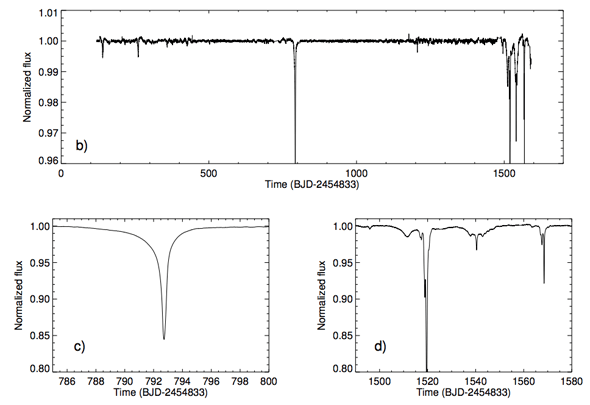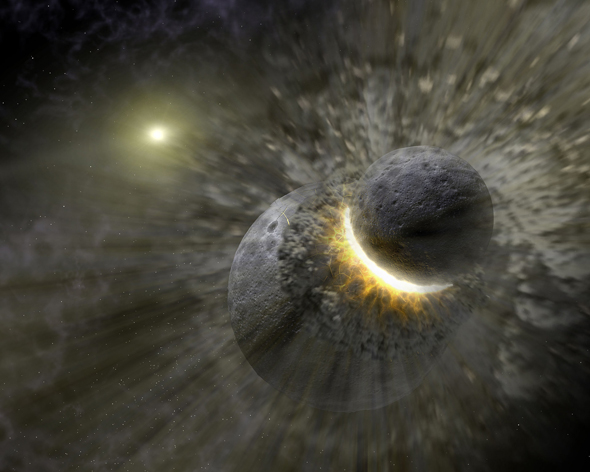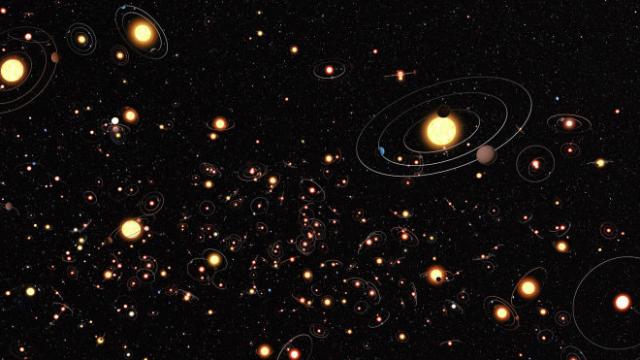This week, the internet worked itself into a frenzy over the possibility that we’ve found an alien megastructure. But whether or not there’s a Dyson sphere buried in the Kepler data, the discovery of a strange, flickering star is very interesting.
Indeed, it points to an entirely new use for the spectral data on 150,000-odd stars that NASA’s Kepler mission spent four years acquiring: Finding and studying really weird astronomical phenomena.
Aliens?!
If you missed the latest alien hysteria, here’s the gist: A thousand light years from Earth in the direction of the Cygnus constellation, a star known as KIC 846285 is behaving in an extraordinary manner. The star flashes and fades, light a lightbulb on a dimmer switch. On several occasions during our four years observing it, its light output dipped by over 20%.
It doesn’t look at all like the planetary transit events Kepler was built to detect — these will cause a star to dim periodically, by about 1% at most. As far as astronomers can tell, there’s nothing else like KIC 846285 in the Kepler database.

Dips in KIC 846285’s brightness over a 1500 day observational period. The bottom two panels are blown-up versions of the top one centered around day 800 and 1500. Image via Boyajian et al.
In a paper released on arXiv, a research team led by Tabby Boyajian proposes a number of natural explanations for the star’s light signature, including giant sunspots, epic clouds of cosmic dust, and a massive collision between two planet-sized objects. All of these scenarios are problematic for one reason or another. The most likely story is that a “family of exocomet fragments” were swept into orbit around KIC 8462582 when another star zipped close by.
Then there’s the unnatural explanation: Aliens. As astronomer Jason Wright explains in a forthcoming paper, KIC 8462852’s light pattern could be consistent with a “swarm of megastructures” built by an alien civilisation to harness the star’s energy. Wright, Boyajian, and UC Berkeley SETI director Andrew Siemion are now proposing that we point a massive radio dish at the star, to hunt for the technobabble of an advanced society.
“I’m still stumped about what could be going on,” Wright told me in an email. “But something is clearly orbiting the star, and whatever they are, they are very large and have complex shapes.”
A New Use For Kepler?
Whether or not the alien explanation holds water — and we should bear in mind that every time researchers have cried aliens in the past, they have been wrong — the fact that KIC 8462852 has piqued the interest of SETI is, in itself, interesting.
The Kepler mission was designed to stare unblinking at a fixed point in the sky, hunting for the tiny shadows of planets transiting across stars. And it’s done a beautiful job. To date, Kepler has uncovered over 4100 planetary candidates and 1000 confirmed exoplanets. Extrapolating from its small cosmic census, astronomers have reached an astounding conclusion.

Artist’s impression of a planet encircling Gliese 667Cb. Image Credit: ESO/L. Calçada
“We have learned most stars have planets, that Earth sized planets are common, and a good fraction are in the habitable zone of their star,” lead Kepler investigator Bill Borucki said at an exoplanet conference I attended this past May. “And when you put the numbers together: 100 billion stars, 10 per cent with Earth-sized planets, 10 per cent stars like the sun, that’s a billion Earth-sized planets in the habitable zone of stars like the sun.”
The Kepler mission has literally revolutionised our view of the cosmos. Thirty years ago, we weren’t sure there were any Earth-like planets beyond our solar system, now, there could be a billion. The possibility of finding life beyond Earth is no longer a pipe dream.
But as recent the Dyson sphere hubbub shows, there’s more to Kepler’s wealth of data than planetary bean counting.

A collision between two massive objects is one phenomena we might discover by looking at starlight. Image Credit: NASA/JPL-Caltech/T. Pyle (SSC)
To wit, by deliberately seeking out weird spectral patterns within Kepler’s dataset, we might discover all sorts of interesting and bizarre astronomical phenomena. Wright imagines quite a few possibilities in a forthcoming paper, including gravitational interactions between planets, massive exomoons, asymmetrical stars, and yes, alien infrastructure. That last one is all that the popular press picked up on, but any of these discoveries would be fascinating.
KIC 8462852 also shows us how to go about finding the cosmically weird and unexpected: Human eyeballs. Our putative Dyson sphere was first noticed by Planet Hunters, a fleet of volunteer citizen scientists who have been trained to trawl through spectral data and pick out stars that look interesting. Because KIC 8462852’s flickering pattern is so irregular, it would have been tough for a computer algorithm to spot. But ordinary men and women on their lunch break could tell that this star was special, and now, SETI astronomers want to point radio telescopes at it.
Kepler’s planet-hunting glory days may be waning — but we’ve just scratched the surface of what this little telescope has to teach us.
Top: Artist’s depiction of planets around stars in the Milky Way. Image Credit: ESO / M. Kommesser
